|
Lithograph from late 18th Century French Catechism
Hark! Hark! The Ark at heavenís gate sings.*
Searching for the Lost Ark of the Covenant
Turn, O backsliding children, saith the Lord;
For I am married unto you: and I will take you
one of a city, two of a family, and I will bring you to Zion:
And I will give you pastors according to mine heart,
which shall feed you with knowledge and understanding.
And it shall come to pass,
when ye be multiplied and increased in the land,
in those days, saith the Lord, they shall say no more,
The ark of the covenant of the Lord:
neither shall it come to mind:
neither shall they remember it;
neither shall they visit it;
neither shall that be done any more.
Jeremiah 3:14-16
It Disappears . . . .
And the Speculation Begins.
By Ron Fritze from Athens, Alabama
Posted February 22, 2010
Most people have heard of the Ark of the Covenant. If you attended parochial school and studied Bible history, you could not have missed it. The same applies if you went to Sunday school on a regular basis because the Ark is the subject of a number of stories in the Old Testament. The Ark has been a fixture of speculation since it disappeared sometime between the reign of King Solomon and Nebuchadnezzar of Babylonís destruction of Jerusalem in 587 BC.
Indiana Jones Raises the Profile.
Over time the Ark moved into the consciousness of popular culture. The screening of the film Raiders of the Lost Ark in 1981 definitely raised the Arkís profile in popular culture. Harrison Ford as Indiana
 Jones, devoted to keeping the sacred Ark of the Covenant out of the megalomaniac hands of Hitler and his nasty Nazi henchmen, is a tremendous amount of fun. Although almost thirty years old, the film story continues to entertain and the special effects continue to wow.
Jones, devoted to keeping the sacred Ark of the Covenant out of the megalomaniac hands of Hitler and his nasty Nazi henchmen, is a tremendous amount of fun. Although almost thirty years old, the film story continues to entertain and the special effects continue to wow.
In Raiders, the Ark is portrayed as a supernatural super-weapon. American intelligence officials, having learned that the Nazis are searching for the Ark, enlist Indiana Jones to keep it out of the hands of the bad guys. Jones eventually makes it to Egypt, where Nazi archaeologists are discovered to be hard at work. The premise is that the Egyptian pharaoh Shishak captured Jerusalem and carried the Ark back home as booty from his conquest. Shishak installed the Ark in his city of Tanis. Soon thereafter, a preternatural sandstorm of massive proportions buried Tanis. The Ark became lost — at least until the Nazis and Jones recover it.
In terms of historical accuracy, the Shishak theory of what happened to the Ark is not really all that well accepted. There are several other theories that are more popular and also more plausible.
It All Began in the Time of Moses.
First, letís ask: What do we know about the Ark?
The Ark first appears in the book of Exodus after Moses has returned from Mount Sinai with the Ten Commandments. God instructed Moses to have it constructed from acacia wood. It was to
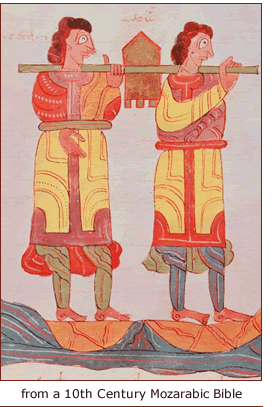 measure two and a half cubits by one and a half cubits by one and a half cubits. According to some analysts, those ancient measurements are equivalent to 45 inches by 27 inches by 27 inches.
measure two and a half cubits by one and a half cubits by one and a half cubits. According to some analysts, those ancient measurements are equivalent to 45 inches by 27 inches by 27 inches.
Moses then delegated the task of building the Ark to the craftsman Bezalel. Rings were attached to the Ark through which poles could be inserted so that the Ark could be carried without the bearers having to touch the actual Ark. An individual who might err and touch the Ark would be put to death.
At some point the Ark was overlaid with gold inside and out. Two winged cherubim were placed the lid of the Ark while thick gold plating was placed at the center of the lid. This center plate was referred to as the Throne of Mercy or the Mercy Seat. It represented the invisible but very real presence of God among his people.
The Ark was built to carry the two stone tablets on which the finger of God had written the Ten Commandments. It was also said that the Ark carried the magical staff of Mosesí brother Aaron and the golden jar that had once contained manna.
Where Goes Israel, So Goes the Ark.
The Ark traveled with the Children of Israel. When they crossed the Jordan River to enter the land of Canaan, priests carried the Ark into the river, which caused it to stop flowing. It dried up on one side of the Ark so that the Children of Israel could pass across in safety. The Ark was also present when the walls of Jericho fell down.
After the Israelites had conquered the land of Canaan, the Ark was kept in sanctuaries at Gilgal, Bochim, Bethel, and Shiloh. It protected the Children of Israel from their enemies — but not always.
At the time that the Prophet Samuel was coming to prominence, the priest in charge of the Ark was a man named Eli. He had two sons, Hophni and Phinehas, who Eli loved and spoiled. As a result, Eli neglected his duties to God. Hophni and Phinehas were just out-and-out evil, taking advantage of their fatherís indulgence to abuse their inherited positions in Israelite society. God was displeased.
Meanwhile, the Israelites were at war with the formidable Philistines. After an Israelite army was defeated by the Philistines, it was decided to bring out the Ark and get God involved in the destruction of the Philistines. Hophni and Phinehas carried the Ark into battle, but God withdrew his support, allowing the Philistines to achieve a great victory. They killed Hophni and Phinehas along with thousands of Israelite warriors.
Righteousness Gained, Ark Lost
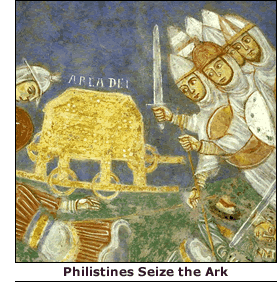 Disastrously for the Israelites, the Philistines captured the Ark. On hearing the news, Eli fell back and broke his neck, leaving Samuel as the spiritual leader of the Israelites. Although righteousness was restored, the Ark remained in enemy hands — but not for long.
Disastrously for the Israelites, the Philistines captured the Ark. On hearing the news, Eli fell back and broke his neck, leaving Samuel as the spiritual leader of the Israelites. Although righteousness was restored, the Ark remained in enemy hands — but not for long.
The triumphant Philistines carried the Ark to their city of Ashdod and placed the trophy in the temple of their god Dagon. However, a vengeful God humbled the idol of Dagon, inflicting tumors on the people of Ashdod. Some scholars today suggest that the tumors were a symptom of an outbreak of bubonic plague, although others identify the tumors as hemorrhoids.
Desperate, the Philistines moved the Ark to Gath, but to no avail. Tumors broke out among the people there. So they moved it to Ekron, where tumors broke out again. Mice also tormented the Philistines, a serious problem for an agricultural people who were trying to store grain for future consumption.
Let's Get Rid of this Thing.
Besieged by pestilence and vermin, the Philistines decided to send their prize trophy back to its rightful owners, the Israelites. Two milk cows were harnessed to a cart on which the Philistines placed the Ark.
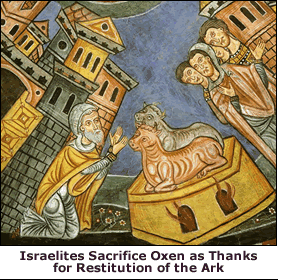 The Philistines also sent a box containing five golden mice and five golden tumors in a effort to propitiate the God of the Israelites.
The Philistines also sent a box containing five golden mice and five golden tumors in a effort to propitiate the God of the Israelites.
Putting the oxen on the road to Beth-shemesh, the lords of the Philistines followed the cart as the cows trudged forward, looking neither to the left nor the right. Once the cart reached Beth-shemesh, it was in Israelite territory. The Israelites in that area saw that the Ark had been returned to them. To celebrate the deliverance, they broke up the cart and set a fire. Then they killed the unfortunate milk cows and offered them as a sacrifice to God along with the golden mice and golden tumors from the Philistines.
Despite this display of Godís power, some of the men of Beth-shemesh showed disrespect by attempting to look inside the Ark. God killed seventy of them for committing sacrilege. At that point the Ark was sent to a new home at Kiriath-jearim where a new caretaker named Eleazar was appointed.
The Tabernacle Is Built . . . .
Then Nothing.
After this adventure, the Ark was housed in a tent known as a tabernacle. During the reign of King David, it was brought to Jerusalem. David never built a temple for the Ark. Instead, that task was performed by his son Solomon, whose temple became the Arkís home. Once the Ark entered Solomonís Temple, it disappears from Biblical history. What happened to it is a mystery.
Obviously, one theory of the fate of the Ark is that Pharaoh Shishak captured Jerusalem and carried the Ark to Egypt as part of the loot.
Another account suggests that Nebuchadnezzar of Babylon captured the Ark when Jerusalem fell in 587/6 BC. The prophet Jeremiah managed to rescue it from the infidels and secreted it in a sealed cave located somewhere on Mount Nebo (see 2 Maccabees 2:4-7).
Talmudic tradition suggests that the cautious King Josiah and the priests of Solomonís temple foresaw the possibility of grave danger threatening the Ark. Aware of the likelihood of an attack by Nebuchadnezzarís army, the priests hid the Ark in the warren of caves located below Solomonís Temple. Ever since, people have attempted to recover the lost Ark by digging on the Temple Mount. The problem is that the Temple Mount is sacred to Judaism, Christianity, and Islam.
According to Islamic teachings, an angel carried the Prophet Mohammed to Jerusalem. To commemorate that miraculous event, pious Muslims built the great mosque known as the Dome of the Rock. The beautiful mosque stands directly over the most likely location for the Ark. Excavation is forbidden.
Did the Knights Find It?
During the Crusades, the Dome of the Rock was controlled by the Knights Templar, who werenít shy about digging on the Temple Mount.
 Wilder speculation claims that they actually found something there — something very powerful that explains how they attained their great prominence in medieval Europe. That something, it has been speculated, was the Ark.
Wilder speculation claims that they actually found something there — something very powerful that explains how they attained their great prominence in medieval Europe. That something, it has been speculated, was the Ark.
If the Templars did find the Ark, what did they do with it? One possibility: They hid it under the Temple Mount and left it there. A more likely possibility: They moved it to the Templar headquarters in France. If so, then what happened to the Ark when the Philip IV of France and the Pope Clement V arrested the Templars of France in 1307?
When Clement V launched his suppression of the order in 1312, heresy trials and executions followed, but many Templars managed to
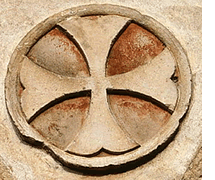 escape. If the Templars actually possessed the Ark, wouldnít they have spirited it away to safe and secret location? If so, a likely destination for the Ark would have been Scotland, where the Templars possessed strongholds and political cover. They may have taken the Ark to Rosslyn Chapel, made famous by The Da Vinci Code. Keep in mind, when people suggest this scenario, they are basing it on speculation piled on speculation piled on more speculation. escape. If the Templars actually possessed the Ark, wouldnít they have spirited it away to safe and secret location? If so, a likely destination for the Ark would have been Scotland, where the Templars possessed strongholds and political cover. They may have taken the Ark to Rosslyn Chapel, made famous by The Da Vinci Code. Keep in mind, when people suggest this scenario, they are basing it on speculation piled on speculation piled on more speculation.
A Prophet from Israel
Becomes the Learned Seer of Ireland.
Another theory concerning the Ark goes back to the Prophet Jeremiah. A tradition claims that Jeremiah, a scribe named Baruch,
 and two princesses of the royal family of the Kingdom of Judah fled when Jerusalem was threatened by the rampaging Babylonian army. They took ship to the mysterious city of Tarshish, also called Tartessus, an ancient metropolis located near Cadiz in southern Spain. They were said to have carried the holy stone known as Jacobís Pillow with them.
and two princesses of the royal family of the Kingdom of Judah fled when Jerusalem was threatened by the rampaging Babylonian army. They took ship to the mysterious city of Tarshish, also called Tartessus, an ancient metropolis located near Cadiz in southern Spain. They were said to have carried the holy stone known as Jacobís Pillow with them.
Others suggest that Jeremiah and his party carried another prize, the blessed Ark, to the mysterious city, and that their arrival at Tarshish was just the beginning of a greater journey. From Tarshish, the story goes, Jeremiah and his companions traveled to Ireland. There the Irish came to know Jeremiah as Ollam Fodhla (learned seer).
The Irish theory continues with the marriage of a princess named Tamar to Heremon Eochaidh, the high king of Ardagh. When Tamar died, she was buried with a mysterious box that contained two documents from Judah on the Hill of Tara, also known as the Hill of the Law. Was Tamarís box the Ark and were the two documents the Ten Commandments?
You can imagine the eagerness of Ark-hunters to excavate Tara. The Irish authorities are just as determined to prevent one of their great historic sites from being dug into a Swiss cheese apparition by dubiously stable people.
Aside: Jacobís Pillow somehow made its way to Scotland, where it became known as the Stone of Scone and served as the coronation seat for the ancient kings of Scotland. Additional aside: All this Jeremiah-and-Tamar-in-Ireland mythology has been utilized to help formulate the racist construction of history favored by the Christian Identity movement.
To Rome by Way of Babylon
Another version of the Ark story assumed it escaped capture by the Babylonians and was placed in the Second Temple of Herod. How this occurred and why nobody commented on it is not explained. If true,
 this theory placed the Ark in the Holy of Holies when the Roman general Titus captured Jerusalem in 70 A.D. The Ark would have been part of the loot from the Templeís treasures, so Titus must have carried it back to Rome to seal his triumph.
this theory placed the Ark in the Holy of Holies when the Roman general Titus captured Jerusalem in 70 A.D. The Ark would have been part of the loot from the Templeís treasures, so Titus must have carried it back to Rome to seal his triumph.
The problem with the Rome-Titus theory is that the Ark is not mentioned as part of Titusís plunder — that is, unless one stretches a single comment made by the Jewish historian Josephus into a more definitive proof. It is hard to believe that as a Jew, Josephus would have treated the Ark in such a casual manner.
In Rome, so the theory continues, the Ark became part of Romeís collection of imperial plunder and remained so for four centuries. Then the barbarians came. Alaric and his Visigoths captured Rome in 410, sacked the city, and then moved-on to settle in southern France and Spain. They are supposed to have taken the Ark with them.
The Visigoths deposited the Ark in Carcassonne. Since the Visigoths practiced Arian Christianity, they were heretics to orthodox Catholics. Somehow Visigothic Arianism made their descendents susceptible to the allure of the dualistic heresy of the Cathars. So when the Cathars became the target of a crusade against heresy, four fugitives from the Cathar movement evaded capture and escaped with the groupís treasures. They supposedly hid the treasure at Rennes-le-Chateau, also made famous in The Da Vinci Code.
Thrilling . . . . and Dubious
During the Nazi occupation of France, occultists associated with Hitler searched for the Ark but failed to find it. Keep in mind, there is no plausible historical evidence for any of these stories. Itís also important to note that the Ark story is definitely conflated with stories about the Holy Grail. It all makes great fodder for thriller novels but offers highly dubious versions of history.
Another explanation, one with a much better although still unsatisfactory foundation in historical evidence, accounts for the disappearance of the Ark by having it spirited away to Ethiopia. That storyís foundation begins with the famous romance of Solomon and the Queen of Sheba.
Sheba's Son Claims the Ark.
Ethiopia has been identified as Sheba, although it is usually located in the southwestern corner of the Arabian Peninsula. Ethiopian traditions claim that Solomon fathered a son with Sheba who was named Menelik and grew up to become the first emperor of Ethiopia. When he reached his young manhood, Menelik visited Solomon, who showered gifts on him. The sons of some Israelite elders accompanied Menelik back to Ethiopia. One of them, Azarius, brought the Ark with him.
Although he was chagrined by Azariusís action, Menelik decided to keep the Ark anyway. He reasoned that it must be Godís will that such an incredible treasure came into his possession. Other versions credit Menelik with the theft of the Ark. Whatever the case may be, Ethiopians believe that the Ark is located in their country, where it lies hidden within the Saint Mary of Zion Church in Axum.
Graham Hancockís book, The Sign and the Seal: The Quest for the Lost Ark of the Covenant (1992), is a sort of travel/memoir of Hancockís efforts to locate the Ark in Ethiopia. He agrees with the Ethiopians that the Ark is sequestered in that church in Axum, even though they would not let him take a look at it. The Sign and the Seal is a speculative book, and some of it is pseudohistorical speculation. Of Hancockís many speculative books, it is the best and the most plausibly possible.
In this Tale, the Ark
Finds Its Way to Southern Africa
Far better than Hancock is The Lost Ark of the Covenant: Solving the 2,500-Year-Old Mystery of the Fabled Biblical Ark by Tudor Parfitt, which was published in 2008. Parfitt, like Hancock, tells his tale of the Ark in the form of a travel narrative and memoir that took place over the course of twenty years. Along the way, Parfitt explores various theories about the location of the Ark, including the Temple Mount, Mount Nebo, and Egyptian ruins. He even visits New Guinea in search of a lost tribe of Israel and the Ark. Most of his book focuses on Africa. His study of the Ethiopian belief that they are the guardians of the Ark leads him to reject its supposed location in the church at Axum.
Tudor Parfitt is a professor of Jewish studies at the School of Oriental and African Studies in the University of London. He knows what he is talking about and he knows the languages. During the course of his career he has also studied the Ten Lost Tribes of Israel, which resulted in the book The Lost Tribes of Israel: The History of a Myth (2002).
Parfittís studies of the Lost Tribes brought him into contact with the Lemba tribe of southern Africa. This tribe had made the seemingly improbable claim that they were a lost tribe of Jews. Amazingly DNA testing has shown that the Lemba did have Middle Eastern DNA, present in four or five male ancestors of the tribe. Further study revealed that the Buba priests of the Lemba possessed the same
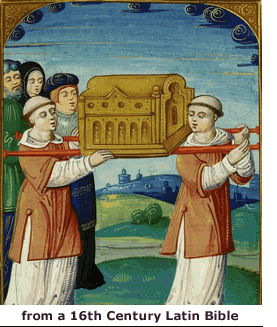 distinct genetic markers as the hereditary Jewish priests of the cohanim. Over time, the four or five Lemba male ancestors intermarried and mingled with the surrounding African peoples, and over more time became physically indistinguishable from other Africans, except for those bits of DNA. The Lemba claim to have the Ark, or Arks, but they call it an ngoma. It is a drum rather than a chest.
distinct genetic markers as the hereditary Jewish priests of the cohanim. Over time, the four or five Lemba male ancestors intermarried and mingled with the surrounding African peoples, and over more time became physically indistinguishable from other Africans, except for those bits of DNA. The Lemba claim to have the Ark, or Arks, but they call it an ngoma. It is a drum rather than a chest.
How did these Middle Eastern and apparently Jewish wanderers reach southern Africa with the Ark in their possession? Parfitt postulates that Jewish priests fled the Kingdom of Judah during the reign of the idolatrous and murderous King Manasseh. According to Parfitt, the priests took the sacred Ark with them. They fled through Arabia to the Hadhramaut of Yemen, moved on to Africa, and eventually made their way to the lands now occupied by the Lemba.
Parfitt tells a fascinating story and presents some interesting evidence. At the end of the speculation, however, this reader is left asking himself: How did the Ark of tradition, with its fairly detailed biblical description, get morphed from a supernatural chest equipped with poles into a big drum that apparently could double as a primitive cannon? Still, if you want to read just one book about the Ark of the Covenant, I recommend Parfittís The Lost Ark of the Covenant.
* With apologies to Shakespeare and Cymbeline II.3.19

Click on the black panther to read about Ron Fritze's latest book,
Invented Knowledge: False History, Fake Science, and Pseudo-religions.
|




 Jones, devoted to keeping the sacred Ark of the Covenant out of the megalomaniac hands of Hitler and his nasty Nazi henchmen, is a tremendous amount of fun. Although almost thirty years old, the film story continues to entertain and the special effects continue to wow.
Jones, devoted to keeping the sacred Ark of the Covenant out of the megalomaniac hands of Hitler and his nasty Nazi henchmen, is a tremendous amount of fun. Although almost thirty years old, the film story continues to entertain and the special effects continue to wow. measure two and a half cubits by one and a half cubits by one and a half cubits. According to some analysts, those ancient measurements are equivalent to 45 inches by 27 inches by 27 inches.
measure two and a half cubits by one and a half cubits by one and a half cubits. According to some analysts, those ancient measurements are equivalent to 45 inches by 27 inches by 27 inches.
 Disastrously for the Israelites, the Philistines captured the Ark. On hearing the news, Eli fell back and broke his neck, leaving Samuel as the spiritual leader of the Israelites. Although righteousness was restored, the Ark remained in enemy hands — but not for long.
Disastrously for the Israelites, the Philistines captured the Ark. On hearing the news, Eli fell back and broke his neck, leaving Samuel as the spiritual leader of the Israelites. Although righteousness was restored, the Ark remained in enemy hands — but not for long. The Philistines also sent a box containing five golden mice and five golden tumors in a effort to propitiate the God of the Israelites.
The Philistines also sent a box containing five golden mice and five golden tumors in a effort to propitiate the God of the Israelites. Wilder speculation claims that they actually found something there — something very powerful that explains how they attained their great prominence in medieval Europe. That something, it has been speculated, was the Ark.
Wilder speculation claims that they actually found something there — something very powerful that explains how they attained their great prominence in medieval Europe. That something, it has been speculated, was the Ark. escape. If the Templars actually possessed the Ark, wouldnít they have spirited it away to safe and secret location? If so, a likely destination for the Ark would have been Scotland, where the Templars possessed strongholds and political cover. They may have taken the Ark to Rosslyn Chapel, made famous by The Da Vinci Code. Keep in mind, when people suggest this scenario, they are basing it on speculation piled on speculation piled on more speculation.
escape. If the Templars actually possessed the Ark, wouldnít they have spirited it away to safe and secret location? If so, a likely destination for the Ark would have been Scotland, where the Templars possessed strongholds and political cover. They may have taken the Ark to Rosslyn Chapel, made famous by The Da Vinci Code. Keep in mind, when people suggest this scenario, they are basing it on speculation piled on speculation piled on more speculation. and two princesses of the royal family of the Kingdom of Judah fled when Jerusalem was threatened by the rampaging Babylonian army. They took ship to the mysterious city of Tarshish, also called Tartessus, an ancient metropolis located near Cadiz in southern Spain. They were said to have carried the holy stone known as Jacobís Pillow with them.
and two princesses of the royal family of the Kingdom of Judah fled when Jerusalem was threatened by the rampaging Babylonian army. They took ship to the mysterious city of Tarshish, also called Tartessus, an ancient metropolis located near Cadiz in southern Spain. They were said to have carried the holy stone known as Jacobís Pillow with them. this theory placed the Ark in the Holy of Holies when the Roman general Titus captured Jerusalem in 70 A.D. The Ark would have been part of the loot from the Templeís treasures, so Titus must have carried it back to Rome to seal his triumph.
this theory placed the Ark in the Holy of Holies when the Roman general Titus captured Jerusalem in 70 A.D. The Ark would have been part of the loot from the Templeís treasures, so Titus must have carried it back to Rome to seal his triumph.
 distinct genetic markers as the hereditary Jewish priests of the cohanim. Over time, the four or five Lemba male ancestors intermarried and mingled with the surrounding African peoples, and over more time became physically indistinguishable from other Africans, except for those bits of DNA. The Lemba claim to have the Ark, or Arks, but they call it an ngoma. It is a drum rather than a chest.
distinct genetic markers as the hereditary Jewish priests of the cohanim. Over time, the four or five Lemba male ancestors intermarried and mingled with the surrounding African peoples, and over more time became physically indistinguishable from other Africans, except for those bits of DNA. The Lemba claim to have the Ark, or Arks, but they call it an ngoma. It is a drum rather than a chest.